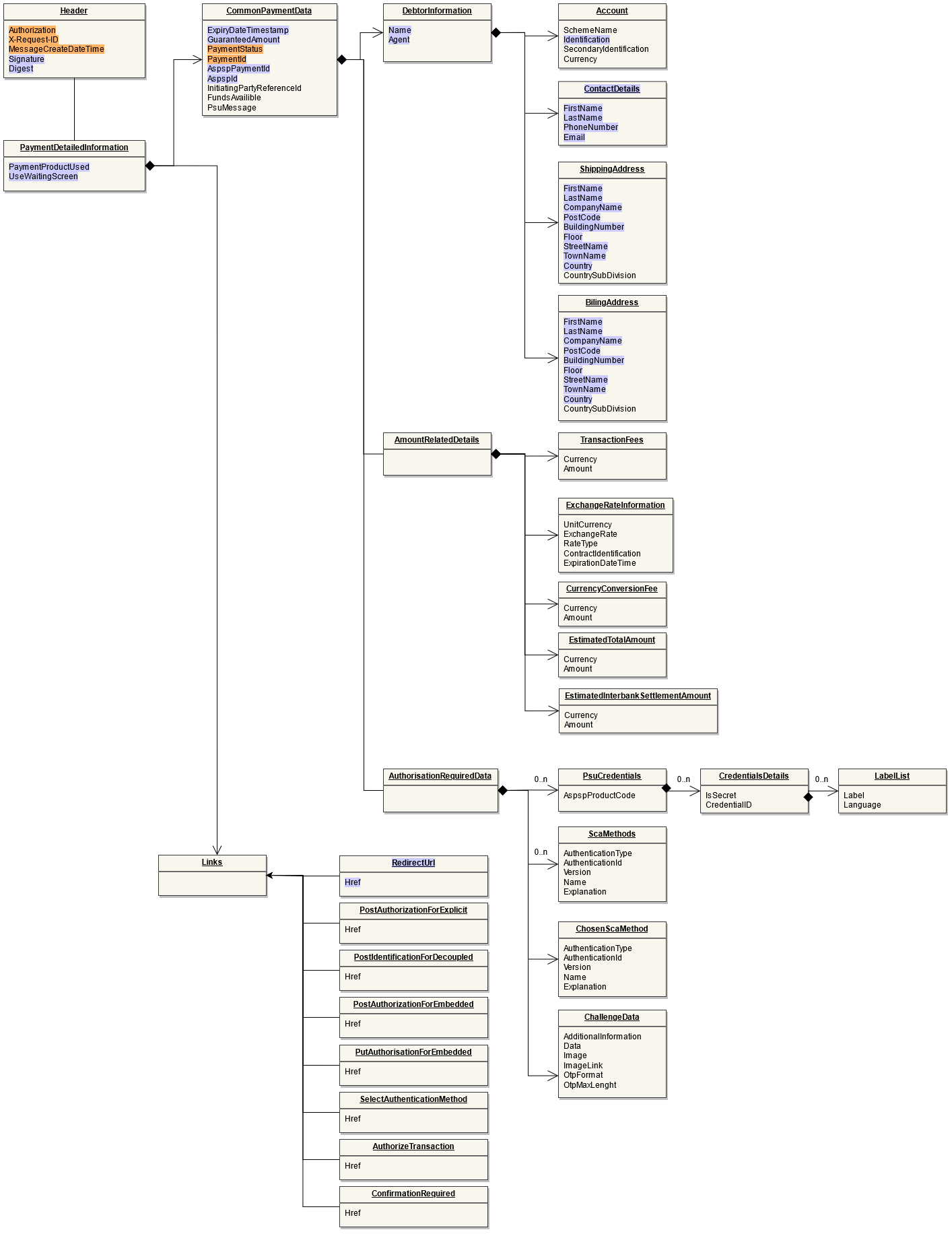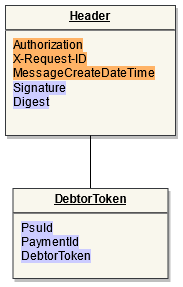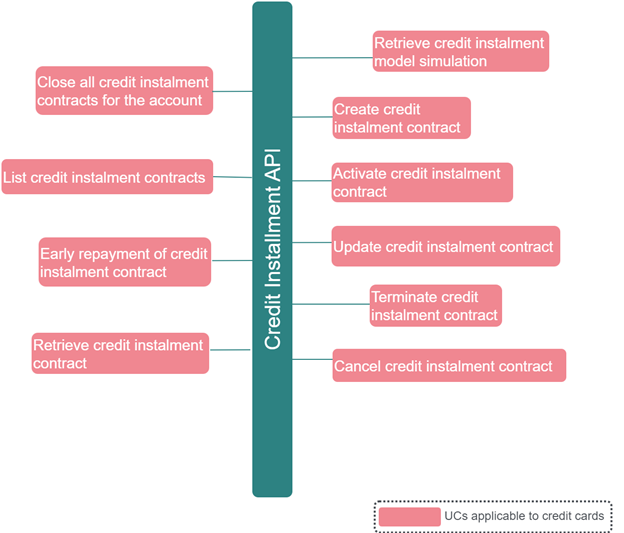ob-p-ideal-notification
The notification APIs described in this chapter needs to be implemented on the Initiating Party side, if the Initiating Party decides to use them. The Open Banking Service will post notifications to these endpoints. For the iDEAL product the post status notification is part of the product, a value-added service is not required (because the notification is part of the iDEAL scheme and the Open Banking Service doesn't have to-do additional polling).
POST Status
Endpoint: POST /status
This API will notify the initiating party about the status of the payment. More details about the fields can be found in the API reference.
Data model
Legend
| |
| Request (click to enlarge) | Response |
 |  |
Example: Notification for Standard iDEAL payment
Request (Signature-related fields "Digest" and "Signature" are conditionally present):
Address: https://checkout.company.com/transaction/webhook/91FA6EEC30844FAAB5/v3/notification/status
HttpMethod: POST
Headers: {Authorization=Bearer 123456789, X-Request-ID=c1452392-6c3f-4365-93f8-40558f61ac36, MessageCreateDateTime=2023-03-15T11:51:24.185+01:00, Digest=SHA-256=0hq1mKzxB1yyc6+hut2bEX7ps+nWyWb2pgQb6AhfhfM=, Signature=keyId="3EBEF6033C00730D9C6DA05165A3CAA1F31036FB",algorithm="rsa-sha256",headers="messagecreatedatetime x-request-id digest",signature="uYgovoK+ibAE7+MzJEKrApDUAgWfUv7RQK22zAxWHCdKCuG4d0HgqpDSqcGlKmP2IMFsC787zDU3oqKeeIIVXR72uZBiOnm0/84UL9e7LVDHDLQsRbfDnmvgX/4xQvdwROmyqh8kkcXTf/48zY0wo2n9iDspCbgTn1DEqAqtAlwunIpea8eYA3FQc+pV2px77wVP7l+9mTxexzLSmum61wWbqE4ESJn0K37gXY54229ZtCnNSlu9rsvjQ5xmDf1e6MvMLBOblXHIReN2t8IH85VGK7mpi8T7JeKb8rIG8qDbQ5TD3BmIS1+RspI95FldLCKLH91/KNrxsgPsrC2QgQ==", Content-Type=application/json}
Payload: {
"PaymentProductUsed" : "IDEAL",
"CommonPaymentData" : {
"GuaranteedAmount" : "10.00",
"PaymentStatus" : "SettlementCompleted",
"PaymentId" : "19928",
"AspspPaymentId" : "0001070883053837",
"AspspId" : "10002",
"DebtorInformation" : {
"Name" : "Edsger Wybe Dijkstra - Callback",
"Agent" : "ABNANL2AXXX",
"Account" : {
"SchemeName" : "IBAN",
"Identification" : "NL44RABO0123456789",
"Currency" : "EUR"
},
"UseWaitingScreen" : false
}
Response:
ResponseCode: 204
Example: Notification for iDEAL Payment with Fast Checkout
Request (Signature-related fields "Digest" and "Signature" are conditionally present):
Address: https://checkout.company.com/transaction/webhook/91FA6EEC30844FAAB5/v3/notification/status
HttpMethod: POST
Content-Type: application/json
Headers: {Authorization=Bearer 123456789, X-Request-ID=c1452392-6c3f-4365-93f8-40558f61ac36, MessageCreateDateTime=2023-03-15T11:51:24.185+01:00, Digest=SHA-256=0hq1mKzxB1yyc6+hut2bEX7ps+nWyWb2pgQb6AhfhfM=, Signature=keyId="3EBEF6033C00730D9C6DA05165A3CAA1F31036FB",algorithm="rsa-sha256",headers="messagecreatedatetime x-request-id digest",signature="uYgovoK+ibAE7+MzJEKrApDUAgWfUv7RQK22zAxWHCdKCuG4d0HgqpDSqcGlKmP2IMFsC787zDU3oqKeeIIVXR72uZBiOnm0/84UL9e7LVDHDLQsRbfDnmvgX/4xQvdwROmyqh8kkcXTf/48zY0wo2n9iDspCbgTn1DEqAqtAlwunIpea8eYA3FQc+pV2px77wVP7l+9mTxexzLSmum61wWbqE4ESJn0K37gXY54229ZtCnNSlu9rsvjQ5xmDf1e6MvMLBOblXHIReN2t8IH85VGK7mpi8T7JeKb8rIG8qDbQ5TD3BmIS1+RspI95FldLCKLH91/KNrxsgPsrC2QgQ==", Content-Type=application/json}
Payload: {
"PaymentProductUsed" : "IDEAL",
"CommonPaymentData" : {
"GuaranteedAmount" : "10.00",
"PaymentStatus" : "SettlementCompleted",
"PaymentId" : "19928",
"AspspPaymentId" : "0001070883053837",
"AspspId" : "RABONL2UXXX",
"DebtorInformation" : {
"Name" : "Edsger Wybe Dijkstra - Callback",
"Agent" : "ABNANL2AXXX",
"Account" : {
"SchemeName" : "IBAN",
"Identification" : "NL44RABO0123456789",
"Currency" : "EUR"
},
"ContactDetails" : {
"FirstName" : "Edsger",
"LastName" : "Dijkstra",
"PhoneNumber" : "+31612345678",
"Email" : "edsger@domain.nl"
},
"ShippingAddress" : {
"FirstName" : "Edsger",
"LastName" : "Dijkstra",
"PostCode" : "52066",
"Country" : "NL"
},
"BillingAddress" : {
"FirstName" : "Edsger",
"LastName" : "Dijkstra",
"PostCode" : "52066",
"Country" : "NL"
}
}
},
"UseWaitingScreen" : false
}
Response:
ResponseCode: 204
POST Debtor token
Endpoint: POST /debtorToken
This API will provide a debtor token update to the Initiating party. More details about the fields can be found in the API reference.
Data model
Legend
| |
| Request | Response |
 |  |
Example: Debtor Token Notification for Standard iDEAL payment
Request (Signature-related fields "Digest" and "Signature" are conditionally present):
Address: https://checkout.company.com/transaction/webhook/91FA6EEC30844FAAB5/v3/notification/status
HttpMethod: POST
Content-Type: application/json
Headers: {Authorization=Bearer 123456789, X-Request-ID=c1452392-6c3f-4365-93f8-40558f61ac36, MessageCreateDateTime=2023-03-15T11:51:24.185+01:00, Digest=SHA-256=0hq1mKzxB1yyc6+hut2bEX7ps+nWyWb2pgQb6AhfhfM=, Signature=keyId="3EBEF6033C00730D9C6DA05165A3CAA1F31036FB",algorithm="rsa-sha256",headers="messagecreatedatetime x-request-id digest",signature="uYgovoK+ibAE7+MzJEKrApDUAgWfUv7RQK22zAxWHCdKCuG4d0HgqpDSqcGlKmP2IMFsC787zDU3oqKeeIIVXR72uZBiOnm0/84UL9e7LVDHDLQsRbfDnmvgX/4xQvdwROmyqh8kkcXTf/48zY0wo2n9iDspCbgTn1DEqAqtAlwunIpea8eYA3FQc+pV2px77wVP7l+9mTxexzLSmum61wWbqE4ESJn0K37gXY54229ZtCnNSlu9rsvjQ5xmDf1e6MvMLBOblXHIReN2t8IH85VGK7mpi8T7JeKb8rIG8qDbQ5TD3BmIS1+RspI95FldLCKLH91/KNrxsgPsrC2QgQ==", Content-Type=application/json}
Payload: {
"PsuId": "TestOSZ",
"PaymentId": "12345",
"DebtorToken": "absjrfergd"
}
Response:
ResponseCode: 204









